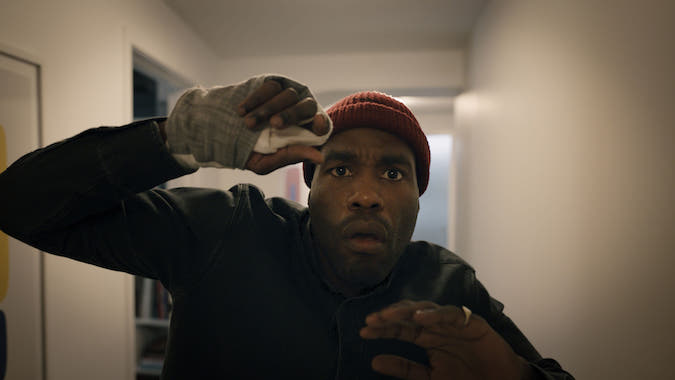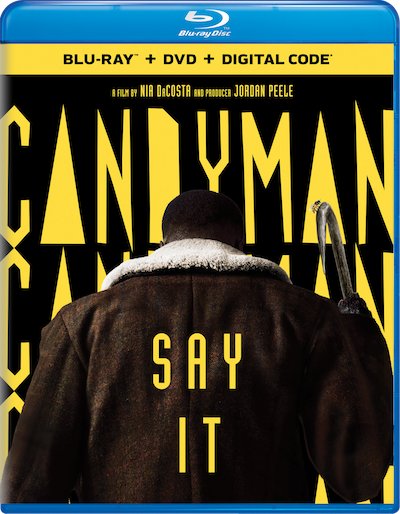
Hot off the heels of Get Out and Us, Jordan Peele returns to the horror genre with Candyman, a sequel to the 1992 cult classic. The titular character originally debuted in the short story, “The Forbidden,” by horror master Clive Barker. Initially taking place in the housing projects of Liverpool, writer/director Bernard Rose transplanted the proceedings to the low-income developments of Cabrini-Green in Chicago. Rose even crafted an all-new origin for the Candyman as the ghost of Daniel Robitaille (played by gravelly voiced Tony Todd), a black man from the late-1800’s who was brutally murdered for falling in love with a white woman. Robitaille’s right hand was cut off and replaced by a hook before his body was smeared with honey and lit on fire.
Peele produced the latest iteration of Candyman and co-wrote the script with Win Rosenfeld and director Nia DaCosta. The original movie was very much an outsider’s view, both in-story and behind-the-scenes, with Virginia Madsen in the lead and a Brit as director. Here, Peele and company give us an insider’s perspective of racism, police brutality, and gentrification.
Anthony McCoy (Yahya Abdul-Mateen II) is an up-and-coming artist living in a toney townhouse built on top of the ashes of the old neighborhood. He lives with his girlfriend Brianna (Teyonah Parris), a gallery curator, but struggles to find inspiration for his next project. That changes when he learns about the urban legend of Candyman, a vengeful spectre that emerges to slay anyone that says his name five times in front of a mirror. While visiting the remains of the Cabrini-Green projects, Anthony meets a laundromat owner named William Burke (Colman Domingo), who recounts his own version of the Candyman tale. Back in the 70’s, Burke encountered Sherman Fields (Michael Hargrove), a homeless eccentric with a penchant for handing out candy to children. Fields was wrongly accused of putting razor blades in his treats and beaten to death by the police. Thus, Candyman becomes a literal hive for victims of racial injustice.
Anthony inadvertently reawakens hook-handed boogeyman with an art piece that dares the viewer to repeat the name Candyman. Those who capriciously say his name are horrifically slaughtered while Anthony, both physically and mentally, descends deeper down the rabbit hole.
From the very start, Nia DaCosta handles Candyman with visual flair. The opening sequence is hot looking up at Chicago’s skyscrapers as they are obscured by a thick fog. This mirror’s the beginning of the original picture, which looked down on the streets of Chicago. The kill sequences are stylish without being overly gory or exploitative. The best moment sees the camera pulling back from a ritzy high-rise apartment as Candyman butchers another victim. Flashbacks and exposition is handled deftly through the use of shadow puppets. DaCosta even gives us a dark version of the old Marx Brothers mirror gag with Abdul-Mateen confronted by his Candyman reflection.
The unsettling atmosphere is accentuated by Cronenberg-esque body horror after Anthony is stung by a bee. Anthony picks at the scab in a truly disgusting scene before his body is steadily consumed by the festering wound.
Video/Audio: 9
The video is presented in 1080p with an aspect ratio of 2.39:1. The transfer is picture perfect with bright, vibrant colors and deep, rich shadows.
The audio is presented with a Dolby Atmos track. The sound will have you looking over your shadow while wondering if Candyman was summoned into your living room. Audio is very immersive with crisp and clear dialogue.
Extras: 6
Say My Name (6:45) is a behind-the-scenes look at the movie as the cast and crew discuss its racial themes amidst current events.
Body Horror (6:22) focuses on makeup and practical effects used to achieve some of the film’s grisly sequences.
The Filmmaker’s Eye: Nia DaCosta (4:44) puts the spotlight on the director as they discuss her work and her connection to the original movie.
Painting Chaos (7:17) looks at art’s role in the story as well as the real-life artists whose work was featured in the film.
The Art of Robert Aiki Aubrey Low (4:54) is all about the film’s composer and how he crafted the score.
Terror in the Shadows (4:09) is a featurette about Manual Cinema, a Chicago-based puppet troupe that created the movie’s shadowbox sequences.
Candyman: The Impact of Black Horror (20:24) sees Colman Domingo moderate a roundtable discussion with several scholars and activists.
Rounding out the extras are an alternate ending and three deleted/extended scenes.
Film Value: 8
It’s a difficult proposition to sequelize a film after an inordinate amount of time has passed. However, it makes perfect sense to create a new iteration of Candyman as so much has changed about the original setting in the ensuing decades. At the same time, the movie’s themes are even more relevant today due to the tragic deaths of Breonna Taylor, George Floyd, Ahmaud Arbery and so many more. Candyman is a gripping horror film that delves into uncomfortable territory.


Comments